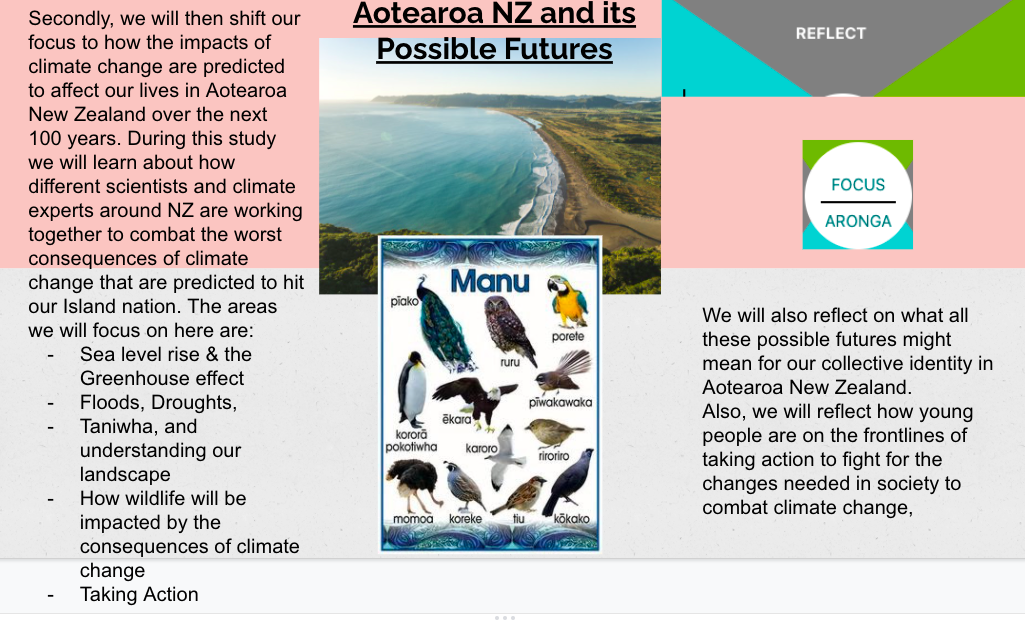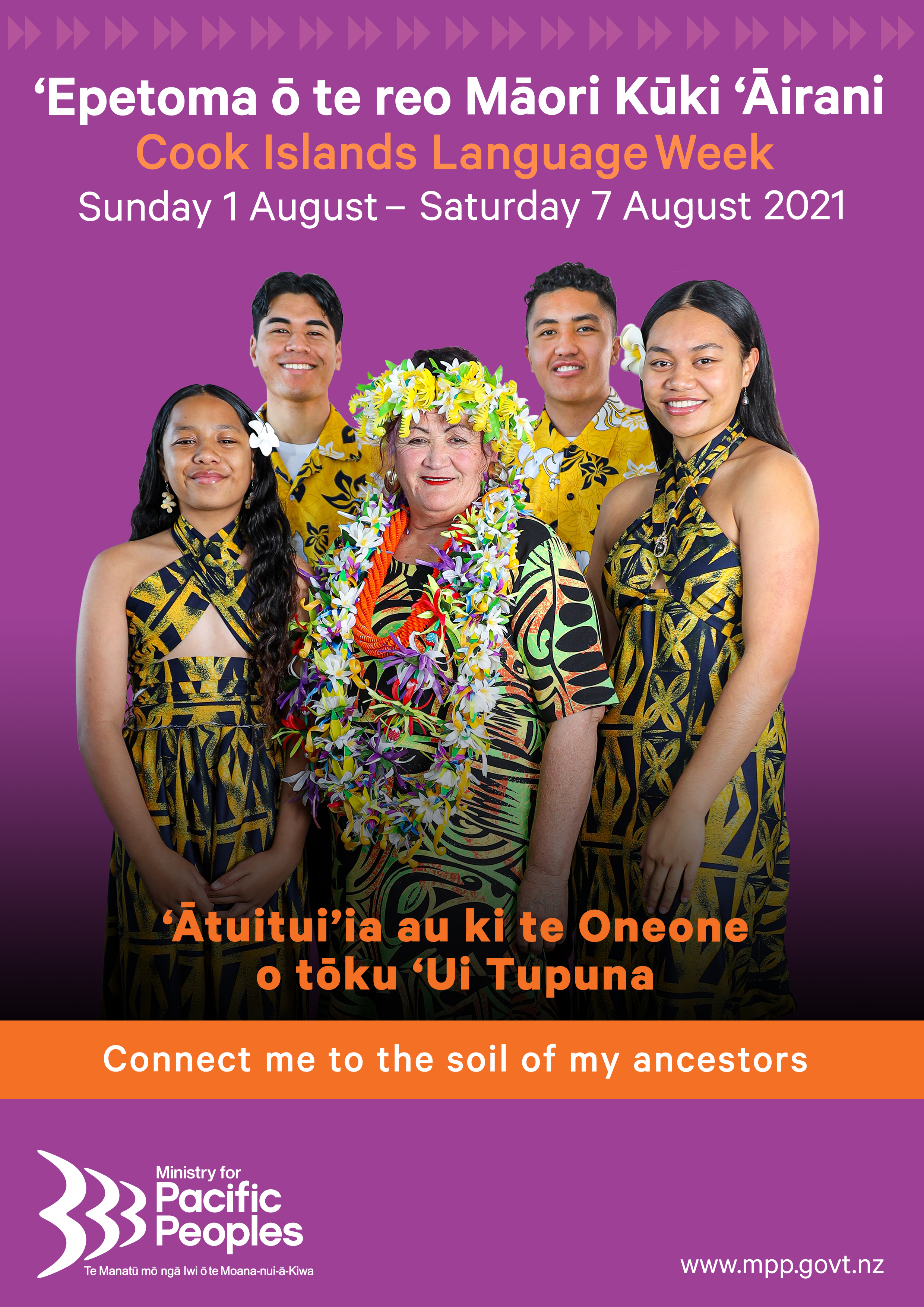7F2 Global Studies
Section outline
-
Tena koutou katoa, welcome to term 1 of our Year 7 Global Studies experience in 2021. Our learning context this term is built around the idea of: Tūrangawaewae - ‘Where do we stand?' Māori World View This idea can be understood in the following Māori proverb: He Whakataukī: “He waka eke noa!”
Metaphorical: A waka we are all in together. We rise together, fall together, work
together and keep going together!
Literal: Working in unity and leaving no-one behind.
Where is my place? Tūrangawaewae are places where we feel especially empowered and connected. They are places linked to the stories of the tūpuna and are woven through the identity of an individual, hapū, and iwi. You may feel that you have your own tūrangawaewae, and this can be investigated and shared to give context and a personal connection to the concept. You may also be students (Māori and others) who don’t have a sense of tūrangawaewae. Do not worry! We can still show and strengthen our connections to our tūrangawaewae. This may include exploring the physical and natural environments of the local area, researching personal and family histories, and including parents and wider whānau in discussion about what tūrangawaewae means to them.
In the coming weeks we will be exploring our personal connections to the stories of ‘our place’ here in the Flatbush community through constructing our own pepeha and learning a new waiata, these will become an important part of our visit to the marae. Our first important event is a visit to Te Whare o Matariki, the local marae located in the Howick Town Centre.
Te whare wananga o Wairoa is situated on the grounds of Emilia Maud Nixon’s Garden of Memories 37 Uxbridge rd, Howick, Auckland Haere mai ki Te Whare o Matariki & Te Whare Taonga (museum), nestled amongst the beautiful gardens & native bush. Te whare Wananga o Wairoa is offering a cultural & history experience for Playcentres, Kindys, daycare & schools, consisting of a Powhiri, history of the gardens, bush walk & a cultural programme run by whaea Taini Drummond. We do have available spots for your parents to accompany you (using their own vehicle) on the day, they only need to bring a gold coin ($1-$2) as a koha - which is required by tikanga (protocol).
This week we will begin our pepeha construction and learn a little bit about the history of the whare we will visit. Below is a photo of the opening of the marae, taken in 1936 and under that a more recent picture is included.
The tūrangawaewae of local iwi and hapū is often represented in a physical sense by the marae at which important hui, celebrations, and farewells are held. For students, visiting the local marae provides an accessible way to explore tūrangawaewae and begin an historical investigation. To prepare for a marae visit, students can develop their own pepeha, a way of personal introduction that emphasises where they are from. With the students, develop a pepeha of the local area and visit all the places mentioned, trying to understand what it is about these places that work together to create tūrangawaewae.
Homework:
Watch the clip below and create 3 questions to submit to Matua Dobson in class next week.
-
Te Whare o Mātariki sits in Emilia Maud Nixon’s Tainui Garden of Memories on Uxbridge road in Howick on the site of the original 1936 Wharewhakairo [image 1 below]
Image 1: The marae in 1947
Image 2: The marae in 1991
Image 3: The original marae was sadly the victim of an arson attack in 2004, in 2007/2008 Te whare o Mātariki was finally rebuilt on the same grounds as the original that was the only identifiable Māori presence in Howick from 1936 up until the arson attack in 2004.
Image 4: Emilia Maud Nixon, the owner of the land on which the Marae now exists - she donated the land to local Māori in the 1930’s as she strongly disapproved of the treatment of Tangata Whenua by local Pākehā settlers throughout her lifetime. [Image 2 below]
Tēnā koutou katoa,
The purpose of our visit to Te Whare o Mātariki is to begin your connection with te ao Māori and the local people who walk in that world. This is our first visit and we will be manuhiri (visitors), but it will not be our last visit - Te whare o Mātariki will be a connection to this place for the rest of your lives; it is my hope that you will gain a feeling of belonging in Aotearoa from this experience, and after this first visit the whānau of that whare will always welcome you back in the future. This is the beginning of shaping your own Tūrangawaewae (place to stand) in our local community. On the day we will experience the powhiri, perform a waiata, share your pepeha, explore the ngahere (forest), & visit the whare taonga (museum). Please bring a packed lunch on the day, there will be some biscuits and drink supplied at the whare too. [image 3 >>]
He Kāpiti hono, he tatai hono. (That which becomes joined remains unbroken)
[<<image 4]
We are learning to…
Understand the tīkanga of powhiri (Kaikaranga, Kaiwhaikorero, Waiata, Hariru, Koha, Tangata Whenua, Manuhiri)
Demonstrate the importance of pepeha
Understand and perform a waiata
I will know I have succeeded when I am able to…
Explain the 5 main aspects of powhiri processes
Say my pepeha in reo Māori & explain what it means in English
Sing the waiata Purea nei confidently & powerfully
-
Te Whare o Mātariki sits in Emilia Maud Nixon’s Tainui Garden of Memories on Uxbridge road in Howick on the site of the original 1936 Wharewhakairo [image 1 below]
Image 1: The marae in 1947
Image 2: The marae in 1991
Image 3: The original marae was sadly the victim of an arson attack in 2004, in 2007/2008 Te whare o Mātariki was finally rebuilt on the same grounds as the original that was the only identifiable Māori presence in Howick from 1936 up until the arson attack in 2004.
Image 4: Emilia Maud Nixon, the owner of the land on which the Marae now exists - she donated the land to local Māori in the 1930’s as she strongly disapproved of the treatment of Tangata Whenua by local Pākehā settlers throughout her lifetime. [Image 2 below]
Tēnā koutou katoa,
The purpose of our visit to Te Whare o Mātariki is to begin your connection with te ao Māori and the local people who walk in that world. This is our first visit and we will be manuhiri (visitors), but it will not be our last visit - Te whare o Mātariki will be a connection to this place for the rest of your lives; it is my hope that you will gain a feeling of belonging in Aotearoa from this experience, and after this first visit the whānau of that whare will always welcome you back in the future. This is the beginning of shaping your own Tūrangawaewae (place to stand) in our local community. On the day we will experience the powhiri, perform a waiata, share your pepeha, explore the ngahere (forest), & visit the whare taonga (museum). Please bring a packed lunch on the day, there will be some biscuits and drink supplied at the whare too. [image 3 >>]
He Kāpiti hono, he tatai hono. (That which becomes joined remains unbroken)
[<<image 4]
We are learning to…
Understand the tīkanga of powhiri (Kaikaranga, Kaiwhaikorero, Waiata, Hariru, Koha, Tangata Whenua, Manuhiri)
Demonstrate the importance of pepeha
Understand and perform a waiata
I will know I have succeeded when I am able to…
Explain the 5 main aspects of powhiri processes
Say my pepeha in reo Māori & explain what it means in English
Sing the waiata Purea nei confidently & powerfully
-
Te wiki o tō mātau haerenga ki te Whare Wānanga o Owairoa
(The week of our visit to the learned house of Owairoa)
Te Whare o Mātariki sits in Emilia Maud Nixon’s Tainui Garden of Memories on Uxbridge road in Howick on the site of the original 1936 Wharewhakairo [image 1 below]
Image 1: The marae in 1947
Image 2: The marae in 1991
Image 3: The original marae was sadly the victim of an arson attack in 2004, in 2007/2008 Te whare o Mātariki was finally rebuilt on the same grounds as the original that was the only identifiable Māori presence in Howick from 1936 up until the arson attack in 2004.
Image 4: Emilia Maud Nixon, the owner of the land on which the Marae now exists - she donated the land to local Māori in the 1930’s as she strongly disapproved of the treatment of Tangata Whenua by local Pākehā settlers throughout her lifetime. [Image 2 below]
Tēnā koutou katoa,
On Friday we will be venturing to Matariki marae in Owairoa. So, this means we need to have our waiata sounding powerful, our pepeha should be practiced daily this week at home, and our understanding of the powhiri process clear. The purpose of our visit is to begin your connection with te ao Māori and the local people who walk in that world. This is our first visit and we will be manuhiri (visitors), but it will not be our last visit - Te whare o Mātariki will be a connection to this place for the rest of your lives; it is my hope that you will gain a feeling of belonging in Aotearoa from this experience, and after this first visit the whānau of that whare will always welcome you back in the future. This is the beginning of shaping your own Tūrangawaewae (place to stand) in our local community. On the day we will experience the powhiri, perform a waiata, share your pepeha, explore the ngahere (forest), & visit the whare taonga (museum). Please bring a packed lunch on the day, there will be some biscuits and drink supplied at the whare too. [image 3 >>]
He Kāpiti hono, he tatai hono. (That which becomes joined remains unbroken)
[<<image 4]
We are learning to…
Understand the tīkanga of powhiri (Kaikaranga, Kaiwhaikorero, Waiata, Hariru, Koha, Tangata Whenua, Manuhiri)
Demonstrate the importance of pepeha
Understand and perform a waiata
I will know I have succeeded when I am able to…
Explain the 5 main aspects of powhiri processes
Say my pepeha in reo Māori & explain what it means in English
Sing the waiata Purea nei confidently & powerfully
1 March - 7 March
Te wiki o tō mātau haerenga ki te Whare Wānanga o Owairoa
(The week of our visit to the learned house of Owairoa)
Te Whare o Mātariki sits in Emilia Maud Nixon’s Tainui Garden of Memories on Uxbridge road in Howick on the site of the original 1936 Wharewhakairo [image 1 below]
Image 1: The marae in 1947
Image 2: The marae in 1991
Image 3: The original marae was sadly the victim of an arson attack in 2004, in 2007/2008 Te whare o Mātariki was finally rebuilt on the same grounds as the original that was the only identifiable Māori presence in Howick from 1936 up until the arson attack in 2004.
Image 4: Emilia Maud Nixon, the owner of the land on which the Marae now exists - she donated the land to local Māori in the 1930’s as she strongly disapproved of the treatment of Tangata Whenua by local Pākehā settlers throughout her lifetime. [Image 2 below]
Tēnā koutou katoa,
On Friday we will be venturing to Matariki marae in Owairoa. So, this means we need to have our waiata sounding powerful, our pepeha should be practiced daily this week at home, and our understanding of the powhiri process clear. The purpose of our visit is to begin your connection with te ao Māori and the local people who walk in that world. This is our first visit and we will be manuhiri (visitors), but it will not be our last visit - Te whare o Mātariki will be a connection to this place for the rest of your lives; it is my hope that you will gain a feeling of belonging in Aotearoa from this experience, and after this first visit the whānau of that whare will always welcome you back in the future. This is the beginning of shaping your own Tūrangawaewae (place to stand) in our local community. On the day we will experience the powhiri, perform a waiata, share your pepeha, explore the ngahere (forest), & visit the whare taonga (museum). Please bring a packed lunch on the day, there will be some biscuits and drink supplied at the whare too. [image 3 >>]
He Kāpiti hono, he tatai hono. (That which becomes joined remains unbroken)
[<<image 4]
We are learning to…
Understand the tīkanga of powhiri (Kaikaranga, Kaiwhaikorero, Waiata, Hariru, Koha, Tangata Whenua, Manuhiri)
Demonstrate the importance of pepeha
Understand and perform a waiata
I will know I have succeeded when I am able to…
Explain the 5 main aspects of powhiri processes
Say my pepeha in reo Māori & explain what it means in English
Sing the waiata Purea nei confidently & powerfully
-
Tena koutou katoa,
On April 9th we will be venturing to Matariki marae in Owairoa. So, this means we need to have our waiata sounding powerful, our pepeha should be practiced daily this week at home, and our understanding of the powhiri process clear. The purpose of our visit is to begin your connection with te ao Māori and the local people who walk in that world. This is our first visit and we will be manuhiri (visitors), but it will not be our last visit - Te whare o Mātariki will be a connection to this place for the rest of your lives; it is my hope that you will gain a feeling of belonging in Aotearoa from this experience, and after this first visit the whānau of that whare will always welcome you back in the future. This is the beginning of shaping your own Tūrangawaewae (place to stand) in our local community. On the day we will experience the powhiri, perform a waiata, share your pepeha, explore the ngahere (forest), & visit the whare taonga (museum). Please bring a packed lunch on the day, there will be some biscuits and drink supplied at the whare too. [image 3 >>]
He Kāpiti hono, he tatai hono. (That which becomes joined remains unbroken)
[<<image 4]
We are learning to…
Understand the tīkanga of powhiri (Kaikaranga, Kaiwhaikorero, Waiata, Hariru, Koha, Tangata Whenua, Manuhiri)
Demonstrate the importance of pepeha
Understand and perform a waiata
I will know I have succeeded when I am able to…
Explain the 5 main aspects of powhiri processes
Say my pepeha in reo Māori & explain what it means in English
Sing the waiata Purea nei confidently & powerfully
-
Assessment 1
-
Tena koutou katoa,
Welcome back for Term 2 7F2!
Our learning context this term is Te Hā o te Wao Nui a Tāne - which basically means: 'the breath of Tāne'.In terms of the Global Studies focus this term, the big idea in the background of what we will be learning and thinking about this term is:
how do different groups of people participate individually and collectively in response to community challenges?
First, we will explore these ideas by looking at the ongoing disappearance of the Amazon Rainforest in Brazil. Here we will examine how different individuals and communities have tried to address the impact of deforestation on their environment.

In week 1 we will aim to achieve two things.
1. Understand the learning pathway we will follow and how it connects to our learning context.
2. Develop our understanding of some key concept-words that we will be engaging with this term.
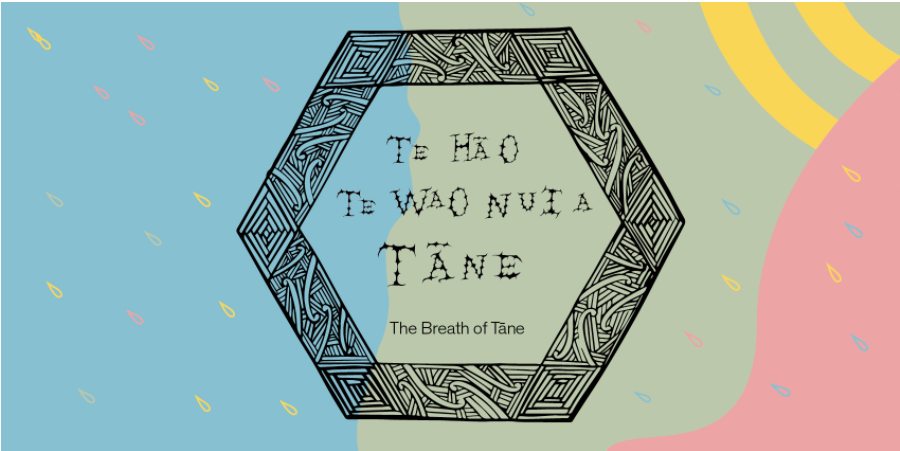
For this week and the next:
WALT...
- describe the pathway of learning we intend to follow in order to deepen our understanding of our learning context in Global Studies.
- explain how the learning context for this term will be engaged with in Global Studies
- identify and define a range of key concepts about rainforests
- identify and define a range of key concepts about deforestation
- locate some of the world's rainforests on a map.

By learning this, you will know how to:
- organise and plan a learning pathway effectively.
- discuss different ideas and issues to do with rainforests and deforestation
- locate the Amazon rainforest on a map/globe
- apply and use key ecological concepts to a real-world context
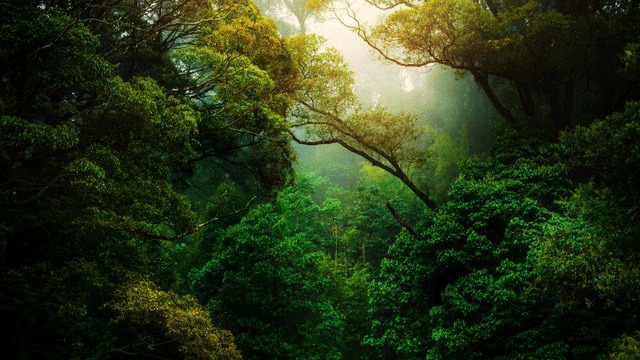
Concept of the Week - Biodiversity
Biodiversity is a term used to describe the enormous variety of life on Earth. It can be used to refer to all of the species in one region or ecosystem. Biodiversity refers to every living thing, including plants, bacteria, animals, and humans. Scientists are interested in how much biodiversity there is on a global scale, given that there is still so much biodiversity to discover. They also study how many species exist in single ecosystems, such as a forest, grassland, tundra, or lake.
A single grassland can contain a wide range of species, from beetles to snakes to antelopes. Ecosystems that host the most biodiversity tend to have ideal environmental conditions for plant growth, like the warm and wet climate of tropical regions. Ecosystems can also contain species too small to see with the naked eye. Looking at samples of soil or water through a microscope reveals a whole world of bacteria and other tiny organisms. Some areas in the world, such as areas of Mexico, South Africa, Brazil, Aotearoa-New Zealand, the southwestern United States, and Madagascar, have more biodiversity than others.
All of the Earth’s species work together to survive and maintain their ecosystems. For example, the grass in pastures feeds cattle. Cattle then produce manure that returns nutrients to the soil, which helps to grow more grass. This manure can also be used to fertilise cropland. Many species provide important benefits to humans, including food, clothing, and medicine. Much of the Earth’s biodiversity, however, is in jeopardy due to human consumption and other activities that disturb and even destroy ecosystems. Pollution, climate change, and population growth are all threats to biodiversity.
For more on biodiversity click here
Case Study: what defines a forest as a rainforest?
Our first case study will take us to the Amazon Rainforest where we will be investigating the recent fires that are threatening to destroy unique animal and plant life that cannot be replaced. These fires also threaten to destroy the homes of the indigenous communities who have lived there for 1000's of years.
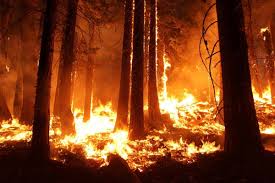
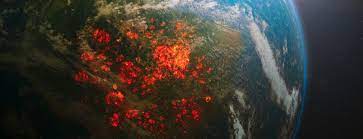
Homework: Rainforests 101
Your first independent study is the homework for this week and looks at what 'Rainforests' are. You will need to watch the clip below titled "Rainforests 101"; and then, use the relevant information from the clip to answer the following questions in your Global Studies Book - head up the page 'Introduction to Rainforests'.
How old are the oldest rainforests?
What kind of rainforests do we have in NZ?
What kind of rainforest is the Amazon?
What is the main difference between temperate and tropical rainforests?
What percentage of the planet’s breathable air is created by rainforests?
-
how do different groups of people participate individually and collectively in response to community challenges?
This week we will continue our investigation into the Amazon Rainforest in Brazil.
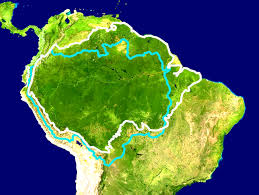
In week 2 we will aim to achieve two things.
1. to recognise and identify the main causes for deforestation in the Amazon and what motivates these causes.
2. to use some of our key concepts to explain how deforestation has both environmental and social impacts on a local and global scale.
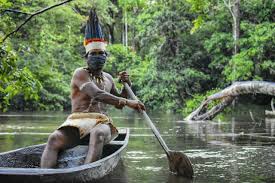
WALT...
- describe the pathway of learning we intend to follow in order to deepen our understanding of our learning context in Global Studies.
- explain how the learning context for this term will be engaged with in Global Studies
- identify and define a range of key concepts about rainforests
- identify and define a range of key concepts about deforestation
- locate some of the world's rainforests on a map.
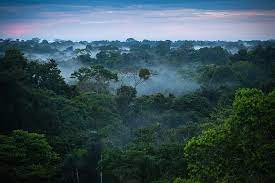
By learning this, you will know how to:
- organise and plan a learning pathway effectively.
- discuss different ideas and issues to do with rainforests and deforestation
- locate the Amazon rainforest on a map/globe
- apply and use key ecological concepts to a real-world context

Concept of the Week - Habitat
A habitat is a place where an organism makes its home. A habitat meets all the environmental conditions an organism needs to survive. For an animal, that means everything it needs to find and gather food, select a mate, and successfully reproduce. For a plant, a good habitat must provide the right combination of light, air, water, and soil. For example, the prickly pear cactus, which is adapted for sandy soil, dry climates, and bright sunlight, grows well in desert areas like the Sonoran Desert in northwest Mexico. It would not thrive in wet, cool areas with a large amount of overcast (shady) weather, like the U.S. states of Oregon or Washington.
For more on habitats click here
The main components of a habitat are shelter, water, food, and space. A habitat is said to have a suitable arrangement when it has the correct amount of all of these. Sometimes, a habitat can meet some components of a suitable arrangement, but not all. For example, a habitat for a puma could have the right amount of food (deer, porcupine, rabbits, and rodents), water (a lake, river, or spring), and shelter (trees or dens on the forest floor). The puma habitat would not have a suitable arrangement, however, if it lacks enough space for this large predator to establish its own territory. An animal might lose this component of habitat—space—when humans start building homes and businesses, pushing an animal into an area too small for it to survive.Case Study 2: Deforestation
watch the clip carefully and discover the answers for the questions below, record your answers in your Global Studies book.
Introduction to Deforestation
How much of the planet is covered in forests?
With the current rates of deforestation, in how many years will the worlds rainforests disappear
How much of a contribution to climate change is made by Forestry and Agriculture?
What two events happen in the process of deforestation that has a negative impact on our climate?
Forests provide habitat (homes) for what percentage of life on Earth?
How many people rely on Forests for food and shelter?
What is the biggest driver of deforestation?
What is “urban sprawl”?
-
Kia ora koutou,
Welcome to Term 3.
The Olympic Games
The Olympic Games are the world's only truly global, multi-sport, celebratory athletics competition. With more than 200 countries participating in over 400 events across the Summer and Winter Games, the Olympics are where the world comes to compete, feel inspired, and be together.

- describe the ancient and modern histories of the Olympic Games
- recognise the significance of the Olympic Games to New Zealand's national identity.
SC
- Explain the significance of the Olympic Games for New Zealand
- provide a detailed account of the similarities and differences between the Ancient and Modern Olympic Games
-
WALT...
-interpret events on a timeline
-identify how the Olympics has impacted ANZ
SC:
Explain a range of connections between Aotearoa New Zealand & the Olympic Games
-
- We are exploring relationships between specific iwi-Māori beliefs/philosophies of kaitiakitanga,whakapapa, and mātauranga/mātauranga-a-iwi
- We are exploring some ideas, beliefs, and concepts that some iwi use to make sense of how Māori relate to the natural world.
- We are exploring how our diverse communities can establish a deeper connection and understanding of ourselves and others through our shared relationship to nature.
-
- We are exploring relationships between specific iwi-Māori beliefs/philosophies of kaitiakitanga,whakapapa, and mātauranga/mātauranga-a-iwi
- We are exploring some ideas, beliefs, and concepts that some iwi use to make sense of how Māori relate to the natural world.
- We are exploring how our diverse communities can establish a deeper connection and understanding of ourselves and others through our shared relationship to nature.
-
- We are exploring relationships between specific iwi-Māori beliefs/philosophies of kaitiakitanga,whakapapa, and mātauranga/mātauranga-a-iwi
- We are exploring some ideas, beliefs, and concepts that some iwi use to make sense of how Māori relate to the natural world.
- We are exploring how our diverse communities can establish a deeper connection and understanding of ourselves and others through our shared relationship to nature.
-
- We are exploring relationships between specific iwi-Māori beliefs/philosophies of kaitiakitanga,whakapapa, and mātauranga/mātauranga-a-iwi
- We are exploring some ideas, beliefs, and concepts that some iwi use to make sense of how Māori relate to the natural world.
- We are exploring how our diverse communities can establish a deeper connection and understanding of ourselves and others through our shared relationship to nature.
-
- We are exploring relationships between specific iwi-Māori beliefs/philosophies of kaitiakitanga,whakapapa, and mātauranga/mātauranga-a-iwi
- We are exploring some ideas, beliefs, and concepts that some iwi use to make sense of how Māori relate to the natural world.
- We are exploring how our diverse communities can establish a deeper connection and understanding of ourselves and others through our shared relationship to nature.
-
- We are exploring relationships between specific iwi-Māori beliefs/philosophies of kaitiakitanga,whakapapa, and mātauranga/mātauranga-a-iwi
- We are exploring some ideas, beliefs, and concepts that some iwi use to make sense of how Māori relate to the natural world.
- We are exploring how our diverse communities can establish a deeper connection and understanding of ourselves and others through our shared relationship to nature.
-
- We are exploring relationships between specific iwi-Māori beliefs/philosophies of kaitiakitanga,whakapapa, and mātauranga/mātauranga-a-iwi
- We are exploring some ideas, beliefs, and concepts that some iwi use to make sense of how Māori relate to the natural world.
- We are exploring how our diverse communities can establish a deeper connection and understanding of ourselves and others through our shared relationship to nature.
-
- We are exploring relationships between specific iwi-Māori beliefs/philosophies of kaitiakitanga,whakapapa, and mātauranga/mātauranga-a-iwi
- We are exploring some ideas, beliefs, and concepts that some iwi use to make sense of how Māori relate to the natural world.
- We are exploring how our diverse communities can establish a deeper connection and understanding of ourselves and others through our shared relationship to nature.
-
- We are exploring relationships between specific iwi-Māori beliefs/philosophies of kaitiakitanga,whakapapa, and mātauranga/mātauranga-a-iwi
- We are exploring some ideas, beliefs, and concepts that some iwi use to make sense of how Māori relate to the natural world.
- We are exploring how our diverse communities can establish a deeper connection and understanding of ourselves and others through our shared relationship to nature.
-
-
Intro to authentic expressions of a bicultural future.
-
-
-

